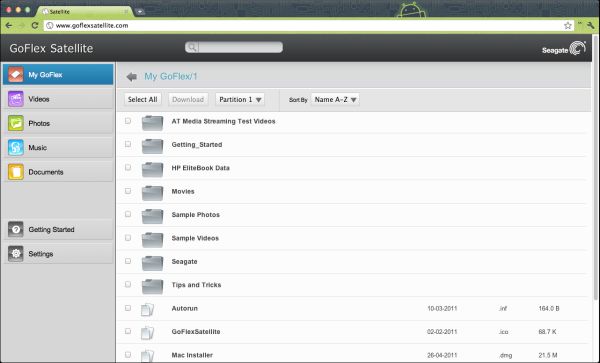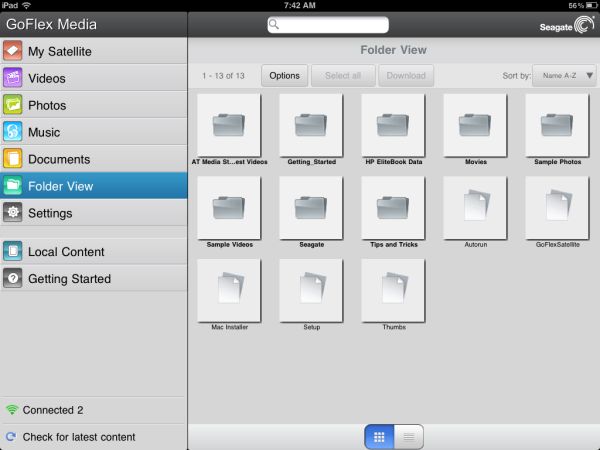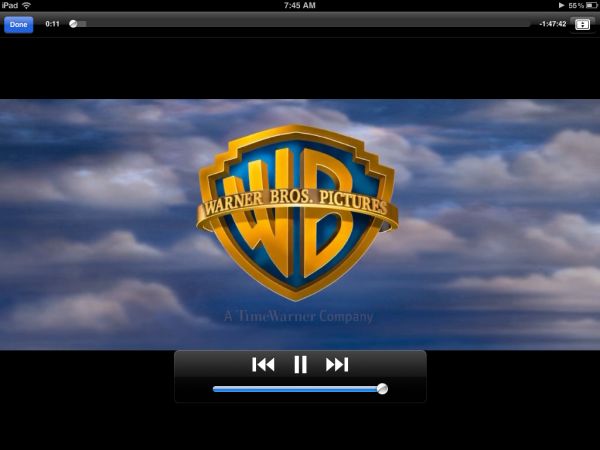Understanding Wireless Storage: Kingston Wi-Drive and Seagate GoFlex Satellite
by Vivek Gowri on November 21, 2011 2:30 PM ESTSeagate's Satellite iOS, Android, and Browser Apps
Seagate gives you more options than Kingston when it comes to connections—the Satellite has a webserver built in that you can connect to from any device that has a browser. Turn the Satellite on, wait for it to show up in the list of available networks, and connect. This is standard stuff, and it doesn’t matter what device you’re using.
Now if you’re trying to connect from a PC or Mac, just open up a browser window, enter any random URL, and it’ll redirect to the GoFlex Satellite webapp (url: www.goflexsatellite.com). You get a GUI with the file system, as well as filtering files by type—videos, photos, music, and documents. There’s also a "Getting Started" page that contains all the documentation and help files, as well as a settings menu. Inside the settings page, you can reboot or shutdown the device, change the SSID, enable WPA security, or reset the settings to default.
The iPad app is pretty similar to the webapp, except with the additional option to play back local content; the Android app looks identical to its iOS counterpart in every way. It’s nice to have a unified UI over all three platforms; it keeps the user experience consistent and overall Seagate has done a good job to make this feel like a cohesive software platform.
Unfortunately, all three options don't give you the same experience when it comes to playing back media. Photos and music are pretty much old hat, and all three platforms handle them with ease. When it comes to video playback, things start to diverge. The iOS app is by far the most seamless, playing every video the iPad supports with no problem regardless of bitrate or file size. The Honeycomb app works similarly in terms of file compatibility, but it does some weird things with the playback—the media player will sometimes forget it’s streaming from a webserver and try to download the file. That's definitely not what I had in mind. The browser player is better than I expected, but it struggles with higher bitrate HD movies and stuff encoded in x264—and by struggles, I mean they flat out refused to play, so that wasn’t useful. Overall, the in-browser webapp works pretty well as long as you make sure the files you’re trying to play are compatible first.













32 Comments
View All Comments
hmurchison - Tuesday, November 22, 2011 - link
Some airlines are now offering in flight Wifi for a fee (usually $6)Kuhnian - Tuesday, November 22, 2011 - link
Can we write data to these devices ? Especially to the bigger one, the GoFlex Satellite.I'm an amateur ohotographer and the first time I heard of Satellite I thought that it could be the final mobile storage solution for photo safaris (100's to 1000's of raw photos in just one session at max resolution needs more than one sd card). I was thinking of connecting my Canon 60D with Satellite through an Eye-Fi card. But at first there wasn't enough info on the net and now after this review I'm beginning to suspect that it can do what I'm dreaming of.
inplainview - Tuesday, November 22, 2011 - link
Yes you can write to it, but if you are on a Mac, there are issues. Apparently there is a problem in Mac OS X 17.x that is causing the Sat not to show up in Finder. When you buy it they give you Paragon's NTFS software that is supposed to let you mount NTFS volumes under Mac OS, but it does not work. If you were to format the drive to read HFS+, you will lose the wifi capabilities, so in effect you can: a) Format the drive HFS+ and lose wifi, b) take your chances with the Paragon software and hope it does not hose your system, c) skip this thing all together and just use a regular external drive. While I like the idea from Seagate, it is not very reliable.Kuhnian - Tuesday, November 22, 2011 - link
I think you missed the point. I mean, can my Eye-Fi adapter send photo data to this disk wirelessly not over the usb (or other ports) cable.name99 - Wednesday, November 23, 2011 - link
The real answer, surely, is that these drives should support WebDAV.I'm kinda amazed that neither of them do --- this seems to indicate extraordinary incompetence on the part of both companies (backed up by this NTFS/reformatting the drive loses wifi nonsense --- WTF --- I perform what is essentially a SW operation and I lose HW functionality???)
IF such a drive supported WebDAV it could then be used by a variety of iOS and Android apps, which support WebDAV, and could (simultaneously, if that is useful) be attached to Finder or Windows Explorer, to allow a PC to easily add and modify files.
marvdmartian - Tuesday, November 22, 2011 - link
Is how easily/possible it would be to take the Seagate drive, and swap out the 2.5" hdd for a decent sized SDD?If it's do-able, that could easily give you the best of both worlds......the speed of the SSD, as well as the lower power consumption. You might not want to go whole hog with a 512GB SSD (as that would probably be prohibitively expensive), but even a 100 to 200GB capacity would still give you plenty of storage, and not break the bank.
name99 - Wednesday, November 23, 2011 - link
Given that we've already been told reformatting the drive LOSES the WiFi functionality --- apparently the genius designers neither included that functionality on separate ROM, nor used firmware tricks to prevent that section of the disk from being touched by a reformat --- swapping drives seems highly unlikely to generate any useful result. You will now have a larger than usual 2.5" drive, with NO WiFi capability, and which cost you a lot more than a standard 2.5" drive.tigertony9 - Tuesday, November 22, 2011 - link
One drive that was missing was the G-Technoogy G-Connect. http://www.g-technology.com/products/g-connect.cfmhmurchison - Tuesday, November 22, 2011 - link
I'm surprised the G-Technology drive is missing from this article. It's different from the GoFlex in that it doesn't offer a battery but it does have Gig-E ethernet so you can put it on a physical network when you need it.addendum:
I don't know why people keep ranting about MicroSD card slots. They're fine for augmenting storage but the ideal behind these products is sharing to multiple users. So if I'm traveling with my kids I can take a loaded drive and they can choose which content they want to watch or listen to. You can do that by simply shoving in SD card.
myapp11 - Tuesday, November 29, 2011 - link
How easy is it to remove the hard drives in the seagate wifi mobile device and the wi-drive device?I want to upgrade the hard drives?
Thanks